
A recent review of the internationally touring exhibition Chiura Obata: American Modern in the Washington Post called Obata's works, "a marvel of invention, nuance and emotional resilience." The exhibition is currently off view since the Smithsonian American Art Museum is closed temporarily as a public health precaution to support the national effort to contain the spread of COVID-19. As the Washington Post notes, "A great artist’s life was interrupted by internment. Now an exhibition of his work is interrupted by a virus."
Many of us are struggling with the idea of forgoing traditional activities during the beautiful season of spring as we do our part to "flatten the curve." After all, who doesn't look forward to the Cherry Blossom Festival, taking a leisurely walk around the Tidal Basin while sampling all sorts of cherry-based desserts? Through this annual event, we all embrace Obata's love of nature and its simple pleasures.
Now that we are all practicing social distancing and mastering this sudden and enormous shift to an almost exclusively online lifestyle (video conference calls, online classes, free educational activities for the little ones in our lives), I find myself looking for ways to reach out and reconnect with friends and loved ones. While technology can be a blessing in allowing us to fee connected while apart, it doesn't replace the in-person, very human connection that we may be craving as well. Which brings me back to Obata.
Obata is known for his exquisite, vibrant watercolor paintings and woodblock prints of national parks such as Yosemite and the Grand Canyon, but he was also a strong believer in the power of the written word. This is a practice I support wholeheartedly as someone who prides herself on handwritten thank you notes.
I was curious to learn more from the artist himself, so I turned to Obata's Yosemite, where I read about Obata's artistic process (even shipping materials from Japan to get the right shades of yellow and green) as well as his personality that came through handwritten letters to his wife Haruko. I was equally impressed by his attention to detail in his correspondence that allows readers to paint their own pictures about his journeys to some of our nation's natural wonders.
In 1927, Obata sent a stream of letters back to Haruko throughout his trip to the High Sierra. No detail was too small, including bringing home a present for hemorrhoid relief (yes, TMI was a thing back then too!), serving as a food monitor against hungry bears, and repeated pleas for Haruko to send $20 to pay for his luggage fees for his return trip.
Despite the sometimes mundane details of his daily activities, what touched me most in his letters was his reverential awe towards Yosemite's natural wonders, big and small:
- On wildflowers: "I picked some wildflowers by the rocks and under the trees around camp and I'm sending them to the children. Tell them not to spoil them. I was very sorry to pick them. Each grass and each flower had long persevered under more than ten feet of snow, until, at last, in the spring they had grown into flowers. But I will send them since I wanted to show them to you."
- On the unusual rock formation Devils Postpile: "It is as if chopsticks hold up thousands of pieces of noodles."
- On pine tree flowers: "[They] spread their roots in the sand between the rocks as joyously as a child who has just awakened and washed his face."
As I admire the beautiful flowers and cherry blossom trees from my window, I try to follow in Obata's footsteps by appreciating the slow and steady cycle of flora and fauna and their annual triumphs against the elements. I also feel inspired by his correspondence, and will send handwritten notes to friends I haven't heard from in awhile, to show I'm thinking of them in my own way.
Want to learn more about Chiura Obata? Browse selected artworks from the exhibition in an online gallery with commentary from the exhibition's curator, ShiPu Wang, and watch the webcast of his talk in which he discusses Obata’s career as a painter, teacher, and cultural ambassador. Read more about Obata's writings from our colleagues at the Archives of American Art.
Katie Hondorf is a public affairs specialist at SAAM.




















